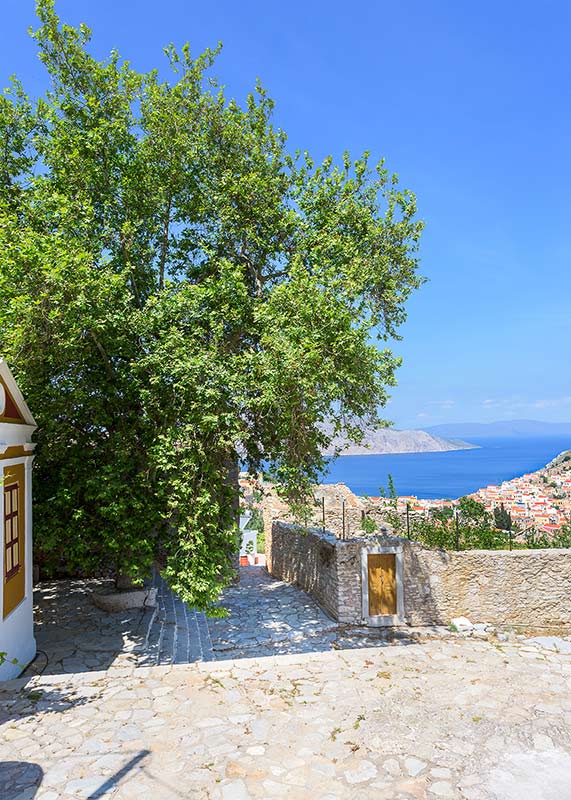THE HIGHEST POINT OF THE ISLAND
THE SQUARE
The “Holly Trinity” district, where Villa Platanos is located, constitutes one of the oldest districts of the settlement. Its location at the highest point, was a precaution, the difficult years of piracy in Southeast Aegean Sea.
THE SQUARE
The clarification of the housing type in the region is slightly difficult, with the sole exception of the late neoclassical buildings. The secular Architecture, with flat chambers and the “patelia” overlap, with rules determined by the rocky multileveled ground, finds its best expression in this area. Taking into consideration the austerity that defines it, interprets the socio -economic conditions of the time of its prosperity. Imposing, the parish church of the Holy Trinity, scouts the area, indicates the affluence of the era, where the trade and sponge fishing flourished.
Academics of Greek and foreign universities, even significant personalities of our country, have opted as a second dwelling ruins of the area, after renovating them, respectfully to the principles regulating the typical architecture of each one. Ongoing private initiatives with the support of the Municipal Authority, aim at the renaissance of the Square, so as to attract more visitors. As a part of this effort, a Greek Music concert is being organized every summer, deploying the amphitheatrical organization of the Square’s stairs.
The area is not accessible via roadway, which is a common fact in Symi, not only to “Gialos”, but also to “Chorio”. Still, it is located very close to places that can be reached by car, such as Panagia Peiraiotissa and Ano Lieni. Materials’ transportation becomes feasible with animals-donkeys, mules, and manually in case of heavy materials.
The supply of food, products and other daily necessities, is made by bakeries and food shops located in the village, with the nearest at a distance of 200 meters. In addition, Traditional taverns and cafes are located in the village, in the neighboring areas at a distance of about 300 meters away.
A discordance of the picture already described, constitutes the remaining ruins. Despite the efforts of the owners to maintain them at least clean, such dilapidated buildings are a “magnet” and a deposition pole of backfill products and garbage.

What to see
Sightseeing in Symi
GIALOS
THe Clock Tower, The Michalaki sculpture and the stone bridge.
KALI STRATA-CHORIO
The oldest shopping street of symi with 500 wide stone stairs.
NIMBORIO
A developing tourist attraction with crystal waters.
PEDI
The road to Pedi follows a very scenic route ascending Noulias hill.
PANORMITIS
The last settlement with the famous monastery of the Archangel Michael of Panormiti.
CHORIO
Walk around the square admire the traditional architecture of Symi and visit the Petinaki.
MARITIME MUSEUM
An elegant building that was renovated with great care and diligence.
CHURCHES AND MONASTERIES
Another characteristic of Symi is the existence of many monasteries and churches.
PATITIRIA
The evolution of the architecture of winepresses sed for crushing grapes by foot.
Gialos
The two side of the port are connected by a stone bridge, which the locals call “kaldrimi”. Nearby there is the picturesque building that houses the Customs and immediately after that the Fish Market. If you start to wander inland, you will reach the square where the Town Hall and Maritime Museum are located.
Moving beyond the Clock Tower and behind the pier heading towards the Yacht Club of Symi (N.O.S.) with its beach, you will find the Harani or shipyard, where the islands old fishing boats were constructed.
Today there are few shipbuilders that you may come across in the Harani working in the shadows of the great masters, mainly as a labor of love and for sentimental reasons. Some of the vessels that you will see are undergoing maintenance and some have been “retired” from the sea creating a unique and emotional picture for many of the locals.
You will find many very good ouzeries on the way there and you will enjoy many wonderful and unique scenes.
KALI STRATA-CHORIO
Walk around the square admire the neoclassical houses with a thousand colors, once inhabited by merchants and captains of the island
Explore the few ‘halata’, dilapidated old houses and to relax in the shade of the pine trees looking towards the shore from high up above, a picture of sublime beauty.Around the village square, you will find beautiful cafes and restaurants with local delicacies that await you.
PEDI
Ask to find out where Lefkantio is, where in the old days the women washed clothes and take a stroll at the second yard of symi.
PANORMITIS
Written evidence of the existence of the monastery exists since the 15th century, and along with Patmos are the two largest and most significant pilgrimages in the Dodecanese
The interior of the monastery is covered with Byzantine frescoes created by the local agiographers. Of importance is the wooden tableau, covered full of offerings and tributes and a gold icon of Archangel.
The monastery complex houses two museums, one housing ecclesiastical art with a rich collection of relics and the other a folklore museum which has a remarkable collection of objects that have to do with the popular culture of the island
Of significance is also the monasteries library which houses about 6,000 old (post-Byzantine manuscripts, manuscripts 16th, 17th, 18th century) and many new volumes with varied content such as theology philosophy, mathematics, medicine, literature etc.
In the monastery complex the ornate and stately steeple stands out, and many have likened it to that of the Zagkorsk Monastery, just outside of Moscow. Of particular interest is the pebbled courtyard with beautiful geometric designs.
CHORIO
This is one of the most distinctive listed buildings of Symi, whose neo-classical elements were added in 1875. In the exhibits, among other things, you will see a reconstruction of the interior of a traditional Symian household, as well as traditional local costumes. The exhibits cover the period from prehistoric to modern times and many were originally small private collections that were donated to enrich the museum. In the museums courtyard ancient inscriptions, sculptures from the early Christian period and amphorae are exhibited
Of particular interest to visitors is Spetsaria, the old pharmacy with old glass jars and the characteristic signs that now operates as a municipal health clinic for the villagers
MARITIME MUSEUM
CHURCHES AND MONASTERIES
At the Panagia tou Kastrou (Lady of the Castle) you can admire the icon of the Second Coming by the post-Byzantine iconographer George Klonza.
At Agios Panteleimon it is worth noting the pebbled floors, depicting an angry mermaid, the sister of Alexander the Great, trying to sink a ship. This scene is in contradiction to the national myth with the mermaid and Alexander the Great, since in this depiction it seems that the captain gave a negative answer as to whether Alexander the Great was alive and the angry mermaid with her face glaring, as illustrated, has grabbed the anchor and turned the boat over.
PATITIRIA
The evolution of the architecture of winepresses, from the first attempt to manufacture them with one stone, to the closed type stone presses, is very interesting.
The first presses were simple, without any particular structure. The only material was a massive stone into which a groove was carved from which the wine would runoff
The second type of winepress included the addition of vertical slabs around the single flat rock so to give the press more height allowing the pressing of more grapes. Outside the runoff point a basin (the “Linos”) was constructed, which gathered the crushed grape juice. The evolution of the winepress continued. The next type had a circular wall constructed by stone, reminiscent of a village oven. Initially it was supported on the back of a rock, but also existed independently thus much taller. With this method the workers and the grapes were sheltered. Later on, a roof with openings to allow for ventilation was added. This type ultimately prevailed throughout the island until the late 18th century, when the cultivation of vines on the island ceased
NIMBORIO
It is one of the oldest settlements in the Island of Symi and and you can get there by taxi boat.
History
The history of Symi island has followed a similar path to that of the other islands in the Aegean: the Romans invaded in the 20th and 10th century BC, followed by the Byzantine period and in the 14th century it was occupied by the Knights of St John. They built a castle on top of the ancient citadel to protect against pirate raids, and remained on the island until the Turks invaded in the 16th century.
The mansions with single or double roofs, with the bi-colored facades in warm colors adorn the 58 square kilometer rock and vying for the spotlight with the irresistible turquoise sea.
The Lady of the Aegean will amaze you with her beauty from the time the ship enters the harbor. And because beauty is captured only in photos that is what you will be constantly trying to do every minute of your stay on the island.
The entire residential complex of Symi has been designated as a “traditional settlement” and indeed it is the largest in the country. On the island there are five settlements, the Symi, Emborios, Pedi, Marathounta, and Panormiti.
The village of Symi has been divided by the locals in two smaller ones. Yialos which is the area around the sheltered harbor up to the nearby hills and the Horio continuing on up higher and around the old castle or else known as Ano Symi.
The Symiams deal mainly with tourism and less with fishing, agriculture and rearing of animals.
Of particular interest is the older art of woodcarving that has been preserved in many mansions and hotels in Yialos.
If you are interested, you will need to look long and hard to discover the few remaining artisans of wood carving and shipbuilding, which were once dominant trades and were part of the rich tradition of Symi.
To see how to build boats in the traditional way, you must visit the two remaining shipyards while to find traditional furniture, made as only Symians knew how, you will need to discover the last two small industries that are solely dedicated to the construction them.
What you also need to know about Symi is that they are known for their longevity. ! In 1497 a famous writer who visited the island, in his writings noted that he met Symians between 120 and 140 years. Recently, in 1999, a survey conducted by French scientists brought to light the phenomenon of the longevity of Symians that reaches up to 120 years.
Scientists attribute the phenomenon of longevity, to the natural way of life that the food mostly comes from the sea and the daily exercise of the residents up and down the countless stairs in their amphitheater styled village. Greek Mythology though gives a different explanation for the phenomenon of longevity of the Symian
Finally Symi has quality accommodations, entertainment, food and also discreet isolation, which makes it particularly endearing to personalities from the international world of show business and beyond. And as for the fact that some people have described Symi as the “Mykonos of the Southern Aegean” they probably rushed to this conclusion, as there is no way you will see the celebrities here, but you will be informed of their presence on the island.

Worth Visiting
Beaches
- NOS
- PEDI
- AGIA MARINA
- SNT NIKOLAS
- SNT GEORGE DISALONAS
- NANOU
- MARATHOUDA
- SNT VASILIS
- SNT EMILIANOS


